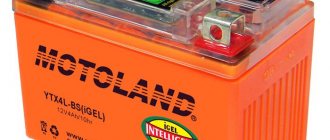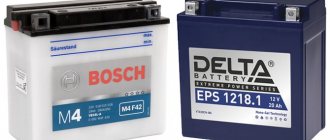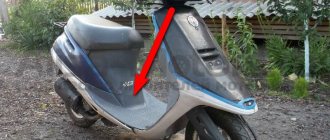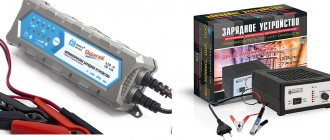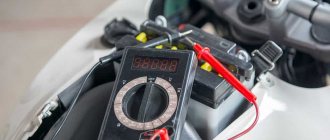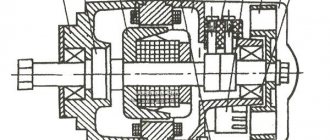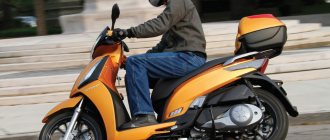Scooter drivers have long become full-fledged participants in traffic in large and small cities. If in winter in the Russian climate it is cold to drive such a vehicle, then in summer there are plenty of them on the streets. Just like a car, a scooter requires a battery. We are talking about a starter battery for starting the engine. The choice of such a battery will be discussed in this article. We will consider the main criteria for choosing a battery for a scooter, types of batteries, lines of some manufacturers, as well as operating requirements.
Choosing a scooter battery
When choosing a battery for a scooter or moped, you need to consider the following points:
- electrical characteristics;
- form factor and design (dimensions, type of terminals, etc.);
- battery type;
- the presence of additional functions that simplify operation (charge indicator);
- brand.
About the types of scooter batteries, suffice it to say here that they are WET, AGM and GEL. In electric scooters you can find lithium-ion batteries, which act as traction batteries rather than starter batteries. Although starter Li-Ion models can sometimes be found on scooters with internal combustion engines (ICE). More details about the types of batteries for scooters will be discussed in a separate section. Examples of battery lines for scooters from various brands will also be given below. Here we will look at the main parameters of batteries.
Electrical characteristics
One of the key parameters for choosing a battery is its capacity. The other two electrical specifications are rated voltage and inrush current.
The vast majority of scooter models are equipped with a battery with a nominal voltage of 12 volts and a capacity of 4 to 9 Ah. On sale you can find motorcycle batteries with a capacity of up to 30 Ah. However, models over 15 Ah are usually installed on motorcycles and ATVs with a large engine capacity. The starting current ranges from 20 to 90 amperes. In the case of lithium-ion starter batteries, this value can reach 180 amperes. However, in most cases, this current is not required to start the scooter engine.
The capacity of the scooter battery should be greater, the higher the engine capacity. A similar relationship can be seen between the magnitude of the starting current and the volume of the motor.
Dimensions and terminals
In the case of scooter batteries, there are significantly more form factors and types of terminals than for car starter batteries. Therefore, the choice here must be made in accordance with the recommendations of the scooter manufacturer or purchase a battery completely similar to the old one. In most cases, the larger the battery's dimensions, the greater its rated capacity. Common sizes include the following:
- 114×39×87, 115×50×86, 120×61×129, 150×86×94, 151×71×107 mm (models with a capacity of up to 9 Ah);
- 150×87×131, 151×71×130, 151×88×147, 207×71.5×164, 151×88×164, 177×88×154 mm (models with a capacity of 10─20 Ah);
- 181×77×167, 176×87×154, 168×126×175, 165×125×175, 205×85×162, 166×130×175 mm (models with a capacity of 20─30 Ah).
The polarity of the batteries can be either direct or reverse. Scooter batteries also have a wide variety of terminals. Some manufacturers may adhere to accepted standards, while others produce batteries with their own type of mounts. At the following links you can read more information about battery polarity and terminals.
Other
Some manufacturers produce battery models with additional capabilities. For example, this could be a charge indicator.
On car batteries, similar indicators have an “eye” that changes color depending on the state of charge. On scooter batteries, similar indicators can be found in the form of a liquid crystal display.
Below you can see what this looks like using Red Energy batteries as an example.
How to replace the battery on a scooter - Scooter-Expert - online magazine about scooters and technology
It is impossible to imagine the operation of the electronic system of a modern scooter without a battery. During the operation of the scooter, periodic replacement of the battery is inevitable, especially if the scooter is used in winter, or the battery is not maintained during this period and remains in the cold. Its service life is thus significantly reduced. Let's look at how to properly replace a scooter battery on your own, it's very simple.
- Place the scooter on the central support and turn off the ignition.
- The design of the scooter has a special compartment for the battery. Depending on the configuration of the scooter, it can be located anywhere. For example, on the Honda Lead AF-48 scooter its place is under the front plastic, in Honda Dio models it is located under the trunk, and in Suzuki Lets scooters, the battery is located under the plastic. If you do not know the location of the battery compartment, this information can be found in the service and repair manual for your scooter. So, the battery compartment, as a rule, is equipped with a cover that is secured with a latch, a self-tapping screw for a screwdriver or hex key, etc. Naturally, the first thing we need to do is open this compartment.
- We see that the positive and negative wires, marked in red and green, respectively, go to the battery. Connections can be covered with casings. The wires are attached to the battery terminals using clamp or spring terminals. First disconnect the negative terminal, then remove the wire from the positive terminal of the battery.
- Now you need to remove the battery. In some cases, the battery fits tightly enough and you don’t need to be afraid to apply force to pull it out.
- The new battery should have similar dimensions so that there are no problems with installation in the standard compartment. It is also necessary to pay attention to the terminals of the new battery - they must be identical to those used in the old one (for example, in both cases there must be clamp terminals or spring terminals, etc.), otherwise connection problems may arise, even if the battery is the right size perfect.
- Before connecting, the wiring terminals must be cleaned with fine-grained sandpaper to remove oxidation elements. We always connect the battery to the scooter’s electrical system with the ignition off.
Everything worked out, the scooter is ready for use.
scooter-expert.com
Types of batteries for scooters
Now let's talk a little about the main types of batteries for scooters. As already mentioned, these are WET, AGM, GEL, Li─Ion.
WET
These are classic lead-acid batteries with liquid electrolyte. The design involves lead alloy plates immersed in a sulfuric acid solution. Unlike WET car batteries, scooter batteries are often sold dry-charged. That is, the package includes the charged battery itself, as well as electrolyte.
Before use, a dry-charged battery must be put into operation. To do this, you just need to pour the electrolyte from the supply kit into the jars and measure the voltage at the current terminals. If it is at the level of 12.5-12.6 Volts, then the battery can be used. If less, then charging is required. Otherwise, WET batteries for scooters are no different from car batteries. The weak points of these models include sensitivity to deep discharge and increased water consumption if the battery is overcharged. Although in modern battery models the electrodes are made of calcium alloy, which lowers the voltage threshold at which hydrolysis begins. This significantly reduces water consumption, and many calcium batteries do not require topping up during their entire service life.
However, the consequences of a deep discharge can be disastrous. If you forget to turn off the headlights or other electrical appliances on the scooter, the battery will discharge to zero and lose part of its capacity. And in some cases it may even fail. Be careful!
AGM and GEL
Both technologies imply the absence of liquid electrolyte. But these are the same lead-acid batteries. The difference from WET is that the electrolyte here is in a bound form.
In the case of AGM, the electrolyte is impregnated with fiberglass that surrounds the lead plates. In GEL type batteries, sulfuric acid is converted into a gel state due to the addition of silicon compounds. And the lead electrodes in this case are surrounded by this gel.
The advantages of AGM and GEL technology include the absence of liquid electrolyte. That is, nothing will spill out of them even if the case is damaged. In addition, they can be used in almost any position. Another major advantage of AGM and GEL compared to WET is resistance to deep discharge. Moreover, even in a discharged state, the battery is capable of delivering a high starting current to start the engine. However, they also have their drawbacks. Their price is higher than standard lead-acid batteries. And besides, they are sensitive to charging mode. If, due to overcharging and excessive current, a standard battery simply “boils” and loses water from the electrolyte, then gel-type batteries may fail. Recharging is critical for them. Therefore, when using such a battery, you need to monitor the state of the on-board network and use an appropriate charger that does not allow them to be overcharged.
Li─Ion
As already mentioned, lithium-ion batteries are most often used on electric scooters as traction batteries. They provide power to the electric motor. Due to their characteristics, lithium batteries are not very suitable for use as starter batteries. However, similar models can also be found on sale. Below in the picture you can see the KTM and Moratti models.
Lithium traction batteries for electric scooters are usually made in the form of an assembly from 18650 standard battery cells.
Exploitation
And in conclusion, a few words about the operation of batteries for scooters.
Selecting a memory
To charge the batteries of scooters belonging to the WET category with liquid electrolyte, it is quite possible to use charger models for car batteries. If you have an AGM or GEL type battery, then you need to use specialized devices to charge them.
The problem is that when overcharged (usually at 14.4 volts), gases begin to be released. This is the result of hydrolysis, which releases hydrogen and oxygen. In the case of liquid electrolyte, the gas is gradually released outside or recombined inside using a special system of channels in the lids.
In AGM and GEL batteries, when overcharged, gas will be released directly at the electrode plates, causing the fiberglass or gel to peel off from them. This will quickly lead to battery failure.
The charger (charger) must be able to charge the battery with a current of 10% of the rated capacity. In the case of AGM and GEL batteries, the charger must conduct the charging process according to a special algorithm that does not allow the release of gases on the electrodes. Typically, recommendations for a charger can be obtained from the manufacturers of batteries or vehicles of this type of battery.
Below are examples of scooter battery chargers.
Storage and maintenance
It is best to store a lead-acid battery in a fully charged state. This applies to both WET and AGM, GEL batteries. In some cases, batteries with liquid electrolyte are even constantly charged at a low current, which compensates for the self-discharge of the battery. As a result, the battery is constantly in a charged state.
Periodically (once a quarter) you need to recharge the battery from the mains charger. The fact is that when charging only from the on-board network during trips, the battery may be in an undercharged state. In winter, such recharging can be done more often (once a month).
There is no need to carry out any “training” of scooter batteries either before use or during use. Lead-acid batteries do not need this. Moreover, it is harmful for them. For WET batteries, complete discharge is generally unacceptable.
If you do not use the scooter for a long time (for example, in winter), you need to remove the battery, fully charge it and store it separately. If you have a lithium-ion battery, you need to store it in a half-charged state. It is also worth adding that the scooter battery must be kept clean. There should be no dust, dirt, or electrolyte leaks on it. Otherwise, a conductive layer is formed on the surface, which contributes to the self-discharge of the battery.
Which memory is better to use?
When purchasing a scooter or moped, it is strongly recommended to read the operating instructions. It describes which batteries are suitable for the selected model and which chargers to use.
Do not try to charge the battery of a charger that is not suitable for this type of battery.
Do you have a scooter or moped? Tell us in the comments what kind of battery you use and how much you like it. This will help make the site content more complete and useful.
